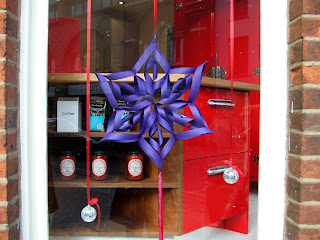The cover of our book is made from mount board cut slightly larger than the pages, covered in crinkled tissue paper and painted in a distressed and gilded finish. I cut out the letters for the word 'colour' from old card in the hope that they would give enough texture under the tissue to show up when it is finished. The whole lot was coated in watered-down PVA before applying the tissue paper.
I experimented on a sample at to whether it mattered what colour the tissue paper was and felt that a darker colour gave a better effect so used purple. The tissue paper was scrunched up into a ball first but it was still difficult to get a nice wrinkled finish. I then coated the whole lot with watered-down PVA again to give it strength.
Now for the fun bit! Using acrylic paints I painted the background with orange, yellow and red streaks. You have to work it into all the wrinkles so it looks really garish at this stage. Next I picked out the lettering in red, orange, yellow, green, blue and purple. The first 3 letters looked good but I was worried that the last 3 looked too obvious. Finally with a very dry brush and hardly any paint I skimmed the tops of the tissue wrinkles with blue and purple paint to bring out the texture and add depth. You can see that I also worked some of the darker colour round the edges for interest.
The last stage was to rub on the gilding cream. You have to do this sparingly as you cannot get it off again if you use too much. I wiped a small amount on a piece of kitchen paper and then stroked it across the 'tops' till I was happy with the effect. Then using my fingers I applied more to the lettering to tone them in further.
Of course I had to do the same for the back cover and also fold the tissue paper over the edges and glue, paint and gild them on the inside as a bit will show around the edges.
I am pleased with the final result - it is amazing what you can do with tissue paper, glue and paint!
I have also been working on the inside pages - see a few below. Overall this has inspired me less than the zig-zag line book shown on the blog in week 10. I think this is because the pages are so small (about the size of a normal paper-back book).
At the end of the class we all made a 'Beady Bod'. This is a fun thing that our tutor sometimes does at shows etc. It has a brooch back and is only about 9cm high, including the legs. This is mine, although it is not really my sort of thing I will pin him on my bag with all the other 'makes'.
At we were leaving our class we noticed that the floristry students in the classroom next door had been busy doing beautiful Christmas displays like this.




































